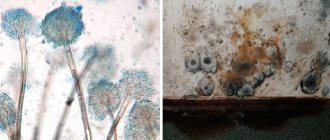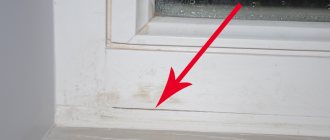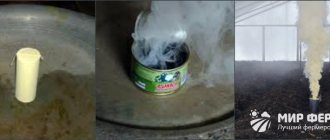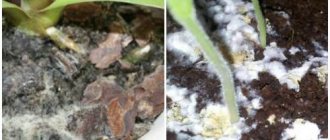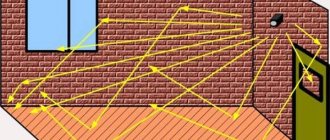Mold easily grows in any basement or cellar. The reason for this is a favorable environment: high humidity, poor ventilation system or poor quality waterproofing.
To prevent this, you need to constantly perform preventive work. If the moldy fungus has already managed to penetrate into the cellar space and is quickly spreading there, folk methods or effective modern drugs will help get rid of it.
What is mold
This substance is a fungal colony. Its spores constantly hover in the air and, when a favorable environment arises, they attach themselves to a suitable surface and begin to quickly take over space and reproduce. To do this, the fungus needs high air temperature and high humidity.
The surfaces on which mold can live are very different. The colony will successfully develop on wood, concrete, brick and other materials. It gradually takes over walls and ceilings, moves to the ceiling and other building structures. Over time, the fungus penetrates the thickness of walls and ceilings and destroys the material. Therefore, if steps are not taken in time to destroy the colony, the house will soon need to be repaired or even rebuilt.
Important! Separate black, brown and white mold. The shade of the fungus indicates class and the age of the colony. Often the color of mold is influenced by the nature of the surface where it grows.
Molds do not develop on their own. Usually there are objective prerequisites for this. The causes of mold in the cellar are:
- insufficient supply of fresh air, poor operation of the ventilation system or its clogging;
- accumulation of condensation as a result of increased moisture or lack of ventilation;
- poor circulation and air stagnation in the cellar space;
- finding rotten foods in storage, which are an excellent breeding ground for the colony;
- use of wood affected by mold as a building material.
What causes fungus to form?
Since ancient times, the cellar and basement have been places intended for storing food supplies. Cold and moisture contribute to a long shelf life of stocks, but at the same time they are excellent conditions for the rapid development and growth of fungi.
The main reasons for the appearance of mold in the cellar are the following factors:
- High temperature level (more than +20);
- Constant humidity above 90%;
- Poor seam insulation;
- High level of residual moisture of materials used in construction;
- Lack or poor waterproofing.
Preventive measures and the fight against fungus should be aimed at installing a high-quality ventilation system and waterproofing of the room.
Poorly insulated walls
Mold is an organism that can live on all surfaces. Its spores are incredibly small and surround a person everywhere, since they are invisible to the human eye. When the spores find a suitable place for their growth, they settle there and begin to actively develop. During the settling of spores in a favorable place, the formation of mycelium occurs, which penetrates deep into the materials and begins to form new spores.
Figure 3. Scheme of external insulation of an underground storage facility
The cellar can be considered the most ideal place for fungus to multiply and this is explained by the following reasons:
- There is poor air flow into the room and there is no oxygen circulation.
- High humidity levels contribute to the formation of condensation on the walls, which cannot evaporate.
- In cellars there are always many sources for feeding fungi (food, wood, concrete), which contribute to the further spread of mold throughout the room.
Figure 3 shows how to properly insulate to prevent mold from appearing in an underground storage facility.
Violation of temperature and humidity conditions
The main reasons for the appearance of mold in the cellar are poor air ventilation and waterproofing, condensation and prolonged storage of spoiled products, as well as the use of shelves made of mold-infected wood.
However, it is customary to identify the following main causes of mold:
- Moisture entering the cellar by capillary action through the walls.
- Water leakage through cracks in walls (structures).
- The presence of poor ventilation, which contributes to the formation of condensation on the walls of the room.
The first signs of mold can be observed when drops of water appear on the walls and structures in the room, in musty and stale air. To combat mold, you should establish a ventilation system and eliminate all sources of water entering the cellar or basement. With these actions, you can establish the air exchange system in the room and the humidity level will return to normal. After bringing the ventilation system back to normal, all that remains is to remove the resulting fungus from the walls.
Floors are not insulated enough
It is possible to get rid of mold in the cellar forever, but to do this it is necessary to eliminate not only visible accumulations, but also to create conditions in which the growth of mold and its existence will be impossible.
Important points:
- Ensuring stable air circulation involves regular ventilation (15-20 minutes per day) and the installation of a comprehensive ventilation system. To ensure air circulation, you can make a hole in the door and leave free space under the door. You can also remove two pipes from the cellar (from the ceiling and from the floor), which will allow oxygen to flow throughout the day and prevent the growth of mold.
- Waterproof the cellar: the complex of waterproofing work includes sealing cracks that can allow moisture to enter the cellar. However, it is impossible to do without covering the walls and floors with moisture-proof materials.
- Reducing the level of air humidity in the cellar. To combat air humidity, you can use heaters or periodically place heated ceramic bricks around the perimeter of the cellar. Reduce air humidity with white moss or containers of slaked lime.
Under what circumstances does fungus grow in the cellar?
Mold does not always appear in the basement. To do this, the following conditions must be simultaneously met:
- The appearance of mold spores in the airspace of the utility room. They can be carried along with food, on human skin or animal fur.
- Presence of a nutrient organic medium. This could be paper, wood fibers, peat pots, fertile soil.
- Microclimate with high humidity and temperature at +20 degrees. Stagnant air increases the likelihood of mold growth.
Not all types of mold require air heating above +20 degrees. There are fungi that successfully reproduce even at 0 degrees.
It is also necessary to note the quality of the ventilation system. The freely circulating air flow does not allow mold spores to gain a foothold on the surface. Therefore, where the air is stagnant, mold forms more often. The movement of air masses in the corners of the room is especially difficult. Therefore, mold grows there more often.
High-quality ventilation does not allow excess moisture to accumulate in the utility room, resulting from a significant difference in temperature between outside and inside or due to increased humidity. Spores are unable to take hold and germinate, even if they are present on structures, but there are no suitable conditions for development. Therefore, the main reason for the development of mold in the cellar is considered to be poor-quality ventilation.
Types of fungus and methods for detecting it
The fungus is one of the most ancient organisms on the planet and its main feature is the ability to absorb the substances it needs from the environment (Figure 4). During the processing of absorbed substances, it releases toxins, carbon dioxide and esters, which are responsible for the peculiar and unique smell of mold.
moldy
The appearance of mold organisms usually occurs on stone or concrete, as well as on all surfaces treated with poor quality paint. This type of mold has spots of black, blue, green or brown color. Mold fungus is capable of destroying materials and can completely destroy the finish, which leads to a complete renovation of the room.
Blue
Blue fungus is the most important danger for wooden houses. When a tree is damaged, spores penetrate into the structure of the tree, after which it changes color to a blue tint.
However, in addition to external changes in the tree, its humidity level increases. With constant penetration of moisture, new types of fungus will appear in the wood.
Rotting fungus
Only wooden surfaces are susceptible to decay fungi, and the microorganisms themselves come in several types. When a tree is damaged by bacterial rot, the color changes to a gray tint and the strength of the material is lost.
Figure 4. Main types of fungus (from left to right): mold, blue, rot
Brown rot can cause even the strongest wood to split in a short period of time. However, we should not forget about white mold, which is the most dangerous for wood, which is known to quickly damage the material and make it unusable. White fungus also tends to spread to neighboring rooms.
Health harm from mold
Not all people know why white mold in the basement is dangerous for building structures and for health. In addition to the danger of injury due to a floor or ceiling destroyed by fungus, mold causes many diseases. Contact with spores of a fungal colony is possible directly with the skin, after inhaling particles along with air, or through eating foods contaminated with the fungus.
Most types of mold reproduce at an incredible rate. After all, just 1 square meter of a colony throws over a billion spores into space. Because of this, after penetration into the body, the fungus provokes various diseases:
- dermatological diseases that develop as a consequence of an allergic reaction;
- diseases of the upper respiratory tract, including sinusitis, nosebleeds, difficulty breathing, chronic runny nose;
- headache and dizziness;
- diseases of the digestive system;
- anemia and exhaustion of the body.
When a person is constantly in contact with mold, serious diseases develop that lead to disability. Elderly people, those weakened by illness, and children are especially sensitive to such proximity.
Important! You can detect the presence of an allergic reaction to mold by passing the appropriate tests. If the diagnosis is confirmed, measures must be taken to destroy the fungal colony.
Why you need to get rid of mold
In basements you can find a variety of types of mold: black, green, white, which looks like lumps of cotton wool. Owners may not pay attention to the fungus that spreads unhindered in utility rooms for a long time, but in vain.
Mold surrounds a person everywhere: it can be in food, on clothes, on almost any surface. The mycelium is capable of penetrating deeply even into stone or concrete, gradually destroying them, not to mention wood and other more fragile materials. If the development of the mycelium is not stopped in time, it may be necessary to replace the finishing or even major repairs of utility rooms. And if the cellar or basement is located in close proximity to housing, then the fungus can spread there too.
If you ignore the development of fungus for a long time, major repairs may be needed.
The place where mold has taken root always has an unpleasant musty smell. Spores, invisible to the eye, settle on food products and enter the body with food or air. Some types of mold are so harmful that they can cause serious diseases of the liver and respiratory system. Most varieties provoke allergic reactions and digestive problems.
For children, the proximity of the fungus is especially dangerous. Once in the respiratory system, spores can reduce local immunity, which leads to frequent colds and asthma. As you can see, you cannot ignore a dangerous neighbor under any circumstances. The sooner you start fighting him, the better.
Food in a cellar affected by fungus is not stored for a long time, quickly deteriorates and becomes dangerous for consumption, and things become saturated with a bad smell of dampness and, if they are not dried in time, are destroyed.
Ways to fight
To completely destroy a mold colony, you need to put in a lot of effort and spend a lot of time. Before treating the room with special preparations, it is necessary to eliminate malfunctions in the ventilation system. Adjust the temperature and humidity levels. Otherwise, despite all efforts, the mold will grow again. Only an integrated approach will help destroy the enemy. The fight against mold in the basement is carried out in several stages.
Preparing the premises
Before getting rid of fungus in a cellar or basement, the room is completely cleared of the objects located there. They take out all products, tools and equipment. This will free up the work front and open access to possible places where fungus accumulates. Removed furniture is also treated with special preparations to avoid re-infection.
The cellar room is thoroughly cleaned and all mold is removed. If building structures are deeply affected by fungus, the parts are replaced with new ones. The earthen floor in the cellar is probably already contaminated with mold spores. Therefore, 20 cm of soil is removed and replaced with new one.
The cleaned cellar room is thoroughly dried. Only after this is it treated with special preparations to completely eliminate the fungus.
Destruction of a moldy colony
Simply removing visible mold and removing fungus in the cellar is not enough for complete destruction. Fungal spores have already penetrated into building structures and surfaces. Therefore, to combat mold in the cellar, they are treated with special antifungal and disinfectant preparations. You can purchase such products at construction and hardware stores. In this case, a good result can be achieved using folk recipes against mold. They are effective and do not harm human health.
Sulfur checker
This device kills mold with sulfur dioxide vapor. The device is very easy to use and effective, so it is recommended to use it first. Before processing, all ventilation holes in the cellar are closed to block air access. The checker is then placed in a metal container and set on fire. Immediately after this, the room is left and the entrance is tightly closed. After 5-6 hours, the cellar is ventilated to remove remaining vapors. Then the floor is covered with slaked lime to remove excess moisture.
Important! Sulfur dioxide is not only harmful to mold. It affects the health of humans and domestic animals. Therefore, they must leave home during treatment.
Vinegar
This product has good cleaning ability and destroys mold spores. White undiluted vinegar is poured into a convenient container. Then dip a brush in the liquid and treat all surfaces in the basement. There is no need to wash the substance with water. 12 hours after treatment, the entrance to the basement and ventilation are opened to get rid of the smell.
Bleaching
The method of getting rid of mold using preparations containing chlorine is comparable in its effectiveness to the action of a sulfur bomb. Any product that contains high concentrations of chlorine is suitable for this method. Inexpensive chlorine bleaches, such as Belizna, are usually used. It is diluted in water, adding 10 parts of water to 1 part of the active substance. Then the liquid is applied to all the walls, ceiling and surfaces of the shelving in the cellar.
Lime
Before using lime to remove mold, the cellar is treated with Dezaktin. It is diluted with water according to the instructions and applied to walls, ceilings and other surfaces. Lime is then applied in one of the following ways:
- 0.5 kg of bleach and 0.2 kg of formaldehyde are dissolved in 10 liters of water. All surfaces in the cellar are coated with this liquid. After this, dry the room and ventilate it.
- 0.5 kg of slaked lime and 50 g of copper sulfate are diluted in 10 liters of water. A spray bottle is used to distribute this solution.
Lemon acid
Using citric acid, you can successfully fight mold in the basement of a private house. To do this, dissolve 100 grams of crystals in 10 liters of water. The resulting solution is sprayed into the cellar. After this treatment, the room is simply dried.
Copper sulfate
Sometimes treating all surfaces with copper sulfate helps remove fungus in the basement of a wooden house. To do this, prepare a solution of 30 liters of water, 250 g of copper sulfate and 2 kg of quicklime. The liquid is applied to the walls, floor and ceiling in the cellar or basement using a paint roller or brush.
Borax
You can get rid of mold in the cellar, if it has appeared there, using borax powder. To do this, prepare a solution of 3 liters of water and 200 g of borax. All surfaces in the cellar are coated with the prepared liquid. It is suitable for treating an attic, shed, garage or basement. To make the result more effective, the solution is not washed off.
Important! When treating a room with a borax solution, wear rubber gloves, as the drug corrodes the skin.
Grapefruit Seed Extract
Treatment with this substance is more of a preventative measure and helps to avoid mold infection. To prepare the solution, take 0.5 liters of water and pour in 20 drops of grapefruit seed extract. The liquid is poured into a spray bottle and all surfaces in the treated area are sprayed. There is no need to rinse off the composition.
Tea tree oil
Tea tree has antibacterial properties. Therefore, its oil ester is able to remove mold. The product is mixed with water and sprayed throughout the cellar. After a few hours, the drug will take effect and the mold spores will die. There is no need to rinse this product off.
Hydrogen peroxide
Hydrogen peroxide has good antifungal and antibacterial effects. Therefore, it is recommended to use it to clean a room of mold. You can use this tool in two ways:
- mix half and half with water and spray all surfaces in the basement;
- coat the walls, floor and ceiling, as well as shelving with undiluted peroxide.
Bleach with slaked lime
Another effective solution for removing mold is prepared from 1 liter of water, 3 tbsp. l. bleach and the same volume of slaked lime. The liquid is thoroughly mixed and applied to all surfaces in the cellar.
Boric acid
Another good way to solve the problem is to treat the cellar against mold and mildew with a solution containing boric acid. To do this, dissolve 1 kg of salt in 5 liters of warm water and add 100 g of boric acid. The ingredients are mixed until completely dissolved and sprayed throughout the room.
Using an ultraviolet lamp
Another way to remove mold in the cellar is exposure to ultraviolet rays. This treatment method will require a powerful quartz lamp or a bactericidal one. It is installed in the center of the cellar. If the infection is concentrated in one area, the lamp is directed towards this place. Then plug the device into the network and leave it for up to 12 hours.
Important! Ultraviolet rays are harmful to the eyes. Therefore, when working with a quartz lamp, they are protected with special glasses. Immediately after connecting the device to the network, they leave the room.
Cleaning the basement with a vacuum cleaner
To reduce the amount of mold and to prevent allergic diseases due to the impact of its spores, it is useful to clean the cellar room, as well as other rooms in the house, with a vacuum cleaner with a HEPA filter. The pores of such a filter are so small that they can retain not only ordinary dust, but also microscopic fungal spores. Therefore, preventive treatment with a HEPA filter helps get rid of allergens and maintain health.
How to get rid of white mold in the basement: microwave method
Professionals use microwave radiation to treat mold, which allows them to heat the infected room to a temperature of more than 60 degrees Celsius. The fungus grows in cool, damp environments and is quickly killed by too high temperatures.
The microwave installation perfectly dries not only concrete walls, but also wood.
It may seem that this method is very simple, but in fact it is impossible to apply it yourself, without special equipment and appropriate skills. Professionals use microwaves to measure the heating temperature of a room using laser pyrometers, since in this situation a regular thermometer, unfortunately, will not give an accurate result.
Using a microwave to clean white mold from a cellar or basement has many advantages:
- With this method, there is no need to use chemicals, which significantly reduces the possible occurrence of negative consequences for human health and life. The method is 100% harmless for the owner of the premises.
- Microwave radiation makes it possible to get rid of mold both outside and inside, that is, directly in the material at a depth of up to 30 cm. Microwave rays, heating the cellar or basement, completely destroy the mycelium of the fungus, completely eliminating its reappearance.
- Microwave radiation propagates through any and any surfaces, be it concrete, brick, plastic or even metal.
- Microwave radiation allows you to treat a room even in very hard-to-reach places, where treatment with chemicals is simply impossible.
Precautionary measures
Since most anti-mold products are quite dangerous if handled carelessly, basement treatment is carried out using personal protective equipment. To do this, before starting work, put on rubber gloves, a respirator or mask, and safety glasses. Exposed parts of the body are protected with a special suit.
Solutions prepared for treatment should not be touched or inhaled. After the antifungal solution is applied to the walls and other surfaces, the room must be left and the entrance closed for several hours.
Important! Do not eat foods contaminated with mold. They will definitely be thrown out.
Fungal colonies and human health
Fungus can not only significantly spoil the appearance of a room, even if it is in the basement. It is very dangerous for humans. In addition, food stored underground in most households can also spoil. Mold can spread to different types of surfaces and objects. It tends to spread very quickly due to reproduction, which can greatly reduce the shelf life and usefulness of products.
These parasites affect people directly through the skin, respiratory or circulatory systems, and through the consumption of contaminated foods. After contact with this “living creature,” the following symptoms and pathologies may develop:
- dermatological skin diseases due to allergies;
- pathologies of the upper respiratory tract (nosebleeds, sinusitis, runny nose, difficulty breathing);
- headache;
- stomach upsets, problems with digesting food, nausea, vomiting;
- general exhaustion of the body, anemia.
If white mold is found in the basement, it must be removed immediately. Let's figure out how to destroy the fungus.
Prevention
After mold is removed from the cellar, it is important to create conditions under which re-infection of the room will be impossible. To do this, you need to maintain a certain microclimate:
- Check the quality of ventilation. If it does not work, troubleshoot. If there is no ventilation at all, it needs to be done.
- The basement is insulated and high-quality waterproofing is created from the outside. It is best to do this during the construction stage, but if desired, work can be carried out after its completion.
- They make a window that is periodically opened to let sunlight into the room.
There should be good air circulation in the cellar so that it does not stagnate. To do this, install open racks with lattice shelves. All products and things are laid out on these structures so that they do not come into contact with the walls.
It is important to monitor the humidity level. If condensation appears, the room is dried and the cause of its formation is eliminated. It is recommended to monitor temperature and humidity using a household thermometer and hygrometer.
Causes of Fluffy White Mold
- Clogged or missing ventilation shafts. Lack of air supply contributes to further mold contamination of the walls.
- Storing rotten vegetables and fruits. Such products are sources of mold.
- Use of wood products that are infected with fungus.
- Increased air humidity, constant accumulation of condensation. As a rule, this aspect depends on the first factor.
- Poor indoor air circulation.
Depending on the size of the fungal colonies, the methods of controlling parasites also differ. Without eliminating the unfavorable factor, it will be very problematic to protect the integrity of the premises and human health.
Reviews
Pavel, 45 years old
I recently discovered black mold in the corners of my basement. It turned out that condensation was accumulating on the walls. We had to urgently dry the room, and we got rid of the mold with a sulfur bomb. A very effective remedy.
Igor, 37 years old
Mold developed on the potatoes in the cellar because it was too warm. We ventilated the cellar and adjusted the ventilation. Of course, I had to throw out some of the potatoes. For prevention, all the walls were coated with bleach.
Danger of fungus to humans
Fungus in the underground of a wooden house is dangerous for people with chronic diseases: allergy sufferers and asthmatics. When spores enter the bronchi, irritation of the mucous membrane occurs. If you do not get rid of mold and mildew in the basement of a wooden house, the person’s condition worsens, since the spores are a strong allergen.
Fungus that appears indoors contributes to the development of diseases. Diseases are divided into groups:
- The first includes invasive skin lesions and bone mycoses. This includes destruction of the nail plates, visual impairment, hearing impairment, etc.
- The second includes external manifestations: vasculitis, eczema, bronchial asthma, dermatitis, etc.
The most dangerous type of parasite is the yellow one, which produces aflatoxin. This substance causes a runny nose, otitis, mycosis, migraine, diseases of the cardiovascular system and others. Black and white mold are not as dangerous. However, any type of mold and fungi in the subfloor or basement must be gotten rid of as soon as possible, since it is harmful to health.
American scientists in their studies have proven that mold is common among the causes of childhood asthma.
A complex approach
To get rid of mold, a comprehensive approach is used:
Preparing the room and clearing space. All things need to be removed. Remove furniture, shelving and other unnecessary items. Food stored in the basement is inspected for the presence of parasites.
Important: If fungus appears on the furniture, it is more convenient to clean it outside. Heavily infested wooden structures should be thrown away.
The earthen floor (if any) is cleaned, removing up to 20 cm of the top layer. Since microorganisms take deep roots, removing the top layer of soil on the floor is necessary.
Experienced people know what to do when fighting mold in the cellar - use antiseptics with antibacterial and antifungal effects.
Traditional methods such as:
- Ammonia.
- Treatment with bleach or other chlorine-containing products.
- Citric acid in high concentration.
- Boric acid with salt.
- Burner.
- Sulfur checker.
- Lime.
- Copper sulfate.
Important: after any type of treatment, you need to leave the room and ventilate. Once the storage area is aired out, conditions are created to prevent the new spread of mold.
How to remove fungus
The first step is to eliminate the cause of the fungus – excessive humidity. Pay attention to the condition of drainage and sewer pipes. If communications are in order, then most likely the reason is something else - ventilation or waterproofing. Mold is afraid of dry, warm, ventilated places, so first check that the hood is working correctly. The fight against fungus and mold in the basement involves a thorough study of the condition of the waterproofing, which directly affects the appearance of moisture in the underground.
Old wooden houses require special attention. Over time, in such buildings the primary waterproofing layer is destroyed and requires urgent renewal. After eliminating the primary causes of the fungus, you can begin the fight against harmful stains on the ceiling, walls, and cellar floor. It is better to take action as soon as mold becomes visible to the naked eye. The fungus actively releases and spreads spores, which are very harmful to the human body - you need to get rid of it urgently.
